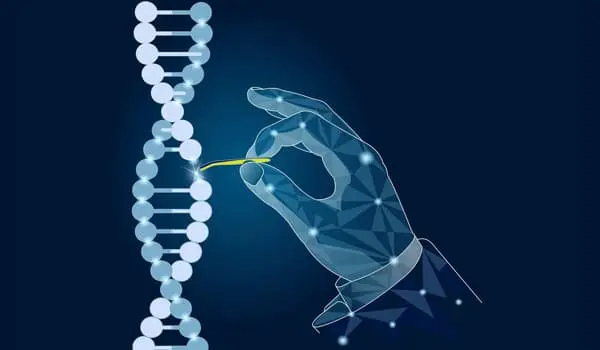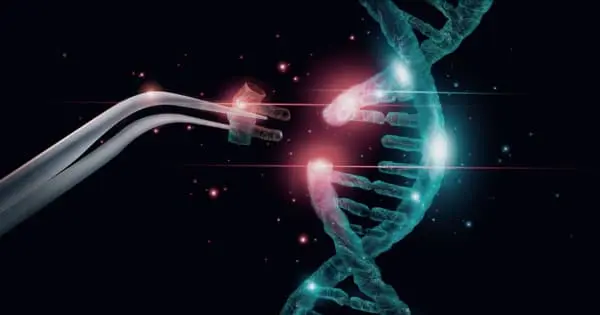Bioengineers repurposed a ‘broken’ CRISPR system to create a miniature version of the genome editing tool. Its small size should make gene therapy delivery into human cells, tissues, and the body easier.
CRISPR gene editing is commonly compared to molecular scissors in that it cuts out specific sections of DNA. That analogy appeals to Stanley Qi, an assistant professor of bioengineering at Stanford University, but he believes it’s time to reimagine CRISPR as a Swiss Army knife.
“CRISPR can be as simple as a cutter or as complex as a regulator, editor, labeler, or imager; many applications are emerging from this exciting field,” said Qi, who is also an assistant professor of chemical and systems biology in the Stanford School of Medicine and a Stanford ChEM-H institute scholar.
The many different CRISPR systems in use or being clinically tested for gene therapy of diseases in the eye, liver, and brain, however, remain limited in their scope because they all suffer from the same flaw: they’re too large and, as a result, too difficult to deliver into cells, tissues, or living organisms.
CRISPR can be as simple as a cutter or as complex as a regulator, editor, labeler, or imager; many applications are emerging from this exciting field. This system didn’t work at all for a year at first. However, after several iterations of bioengineering, we noticed that some engineered proteins began to activate as if by magic. It made us realize how powerful synthetic biology and bioengineering can be.
Stanley Qi
Qi and his colleagues announce what they believe is a major step forward for CRISPR in a paper published in Molecular Cell: an efficient, multi-purpose, mini CRISPR system. Whereas most CRISPR systems, with names like Cas9 and Cas12a denoting different versions of CRISPR-associated (Cas) proteins, have 1000 to 1500 amino acids, their “CasMINI” has 529.
Experiments confirmed that CasMINI, like its beefier counterparts, could delete, activate, and edit genetic code. Because of its smaller size, it should be easier to deliver into human cells and the human body, making it a potentially useful tool for treating a variety of ailments such as eye disease, organ degeneration, and genetic diseases in general.
Persistent effort
To keep the system as small as possible, the researchers began with the CRISPR protein Cas12f (also known as Cas14), which has only 400 to 700 amino acids. Cas12f, like other CRISPR proteins, is derived from Archaea (single-celled organisms), which means it is unsuitable for mammalian cells, let alone human cells or bodies. Only a few CRISPR proteins are known to function normally in mammalian cells. CAS12f, however, is not one of them. For bioengineers like Qi, this makes it an appealing challenge.

“OK, millions of years of evolution haven’t been able to turn this CRISPR system into something that works in the human body, we reasoned. Can we change that in a year or two?” Qi stated. “To the best of my knowledge, we have converted a nonworking CRISPR into a working one for the first time.”
Indeed, Xiaoshu Xu, a postdoctoral scholar in the Qi lab and the paper’s lead author, discovered no activity of natural Cas12f in human cells. The problem, according to Xu and Qi, is that human genome DNA is more complicated and less accessible than microbial DNA, making it difficult for Cas12f to find its target in cells. She carefully selected about 40 mutations in the protein that could potentially bypass this limitation by looking at the computationally predicted structure of the Cas12f system and established a pipeline for testing many protein variants at once by looking at the computationally predicted structure of the Cas12f system. In theory, a functional variant would turn a human cell green by activating green fluorescent protein (GFP) in its genome.
“This system didn’t work at all for a year at first,” Xu explained. “However, after several iterations of bioengineering, we noticed that some engineered proteins began to activate as if by magic. It made us realize how powerful synthetic biology and bioengineering can be.”
The initial successes were modest, but they excited Xu and encouraged her to keep going because it meant the system was working. She was able to improve the protein’s performance over many more iterations. “We started with only two cells showing a green signal, and now almost every cell is green under the microscope,” Xu said. “At some moment, I had to stop her,” recalled Qi. “I said ‘That’s good for now. You’ve made a pretty good system. We should think about how this molecule can be used for applications.'”
The researchers engineered the RNA that guides the Cas protein to its target DNA in addition to the protein. Both components needed to be modified in order for the CasMINI system to function in human cells. They examined CasMINI’s ability to delete and edit genes in human cells grown in the lab, including those involved in HIV infection, anti-tumor immune response, and anemia. It worked on almost every gene they tested, with strong responses in a few of them.
Opening the door
The researchers have already begun to form collaborations with other scientists in order to pursue gene therapies. They are also curious about how they can contribute to advances in RNA technologies, such as those used to develop the mRNA COVID-19 vaccines, where size can also be a constraint.
“This ability to engineer these systems has been sought after in the field since the early days of CRISPR, and I feel like we did our part to move toward that reality,” Qi said. “And this engineering approach can be extremely beneficial. That’s what excites me: the prospect of new possibilities.”





